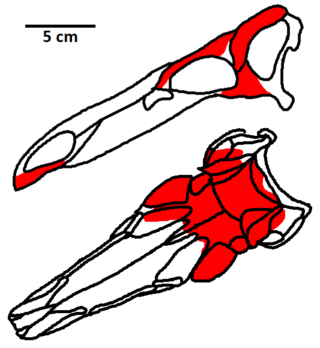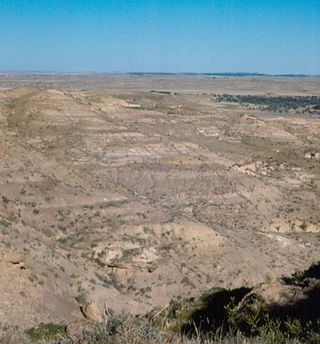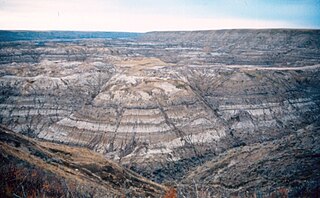
Bruhathkayosaurus is a controversial genus of sauropod dinosaur found in the Kallamedu Formation of India. The fragmentary remains were originally described as a theropod, but it was later determined to be a titanosaurian sauropod. Length estimates by researchers exceed those of the titanosaur Argentinosaurus, as longer than 35 metres (115 ft) and weighing over 80 tonnes. A 2023 estimate placed Bruhathkayosaurus as potentially weighing approximately 110–170 tonnes. If the upper estimates of the 2023 records are accurate, Bruhathkayosaurus may have rivalled the blue whale as one of the largest animals to ever exist. However, all of the estimates are based on the dimensions of the fossils described in Yadagiri and Ayyasami (1987), and in 2017, it was reported that the holotype fossils had disintegrated and no longer exist.

Ariyalur district is an administrative district, one of the 38 districts in the state of Tamil Nadu in India. The district headquarters is located at Ariyalur. The district encompasses an area of 1,949.31 km2.

Dravidosaurus is a controversial taxon of Late Cretaceous reptiles, variously interpreted as either a ornithischian dinosaur or a plesiosaur. The genus contains a single species, D. blanfordi, known from mostly poorly preserved fossils from the Coniacian of southern India.

The Lance (Creek) Formation is a division of Late Cretaceous rocks in the western United States. Named after Lance Creek, Wyoming, the microvertebrate fossils and dinosaurs represent important components of the latest Mesozoic vertebrate faunas. The Lance Formation is Late Maastrichtian in age, and shares much fauna with the Hell Creek Formation of Montana and North Dakota, the Frenchman Formation of southwest Saskatchewan, and the lower part of the Scollard Formation of Alberta.

The Horseshoe Canyon Formation is a stratigraphic unit of the Western Canada Sedimentary Basin in southwestern Alberta. It takes its name from Horseshoe Canyon, an area of badlands near Drumheller.

The Laramie Formation is a geologic formation of the Late Cretaceous (Maastrichtian) age, named by Clarence King in 1876 for exposures in northeastern Colorado, in the United States. It was deposited on a coastal plain and in coastal swamps that flanked the Western Interior Seaway. It contains coal, clay and uranium deposits, as well as plant and animal fossils, including dinosaur remains.

The Lameta Formation, also known as the Infratrappean Beds, is a sedimentary geological formation found in Madhya Pradesh, Gujarat, Maharashtra, Telangana, and Andhra Pradesh, India, associated with the Deccan Traps. It is of the Maastrichtian age, and is notable for its dinosaur fossils
The Maevarano Formation is a Late Cretaceous sedimentary rock formation found in the Mahajanga Province of northwestern Madagascar. It is most likely Maastrichtian in age, and records a seasonal, semiarid environment with rivers that had greatly varying discharges. Notable animal fossils recovered include the theropod dinosaur Majungasaurus, the early bird Vorona, the paravian Rahonavis, the titanosaurian sauropod Rapetosaurus, and the giant frog Beelzebufo.
Argiles et Grès à Reptiles Formation also known as the Argiles Rutilantes Formation is an early Maastrichtian French geologic formation in the département of Var preserving the remains of several types of dinosaurs and other extinct organisms.

The Javelina Formation is a geological formation in Texas. Dating has shown that the strata date to the Maastrichtian stage of the Late Cretaceous, approximately 70 to 66.5 million years old. The middle part of the formation has been dated to about 69 million years ago plus or minus 1 million years and the top situated near the Cretaceous–Paleogene boundary, dated to 66 Ma ago. Dinosaur remains are among the fossils that have been recovered from the formation.

The Prince Creek Formation is a geological formation in Alaska with strata dating to the Early Maastrichtian stage of the Late Cretaceous. Dinosaur remains are among the fossils that have been recovered from the formation.
The Kallakurichi Formation, alternatively spelled as Kallankurichchi or Kallankurichi Formation, is a geological formation of the Ariyalur Group in Tamil Nadu, southern India whose strata date back to the Maastrichtian stage of the Late Cretaceous. Dinosaur eggs of Megaloolithus cylindricus are among the fossils that have been recovered from the sandy limestones of the formation.
Elaiyur is a large village located in the Udayarpalayam Taluk of Tamil Nadu, India. The village is named after the Eallaiyur temple, located at the border of Gangaikonda Cholapuram.
The Intertrappean Beds are a Late Cretaceous and Early Paleocene geologic formation in India. The beds are found as interbeds between Deccan Traps layers, including the slightly older Lameta Formation. The formation spans the Cretaceous–Paleogene boundary, with a stratigraphic range of only a few hundred thousand years before and after the boundary, and a significant debate exists about whether specific sites belong to the Cretaceous or the Paleocene.
The Sierra Perenchiza Formation is a late Campanian to late Maastrichtian geologic formation in Spain. Dinosaur, pterosaur, turtle, lissamphibian, frog and albanerpetontid remains are among the fossils that have been recovered from the formation, although none have yet been referred to a specific genus and the crocodylomorphs Acynodon, Doratodon ibericus and Musturzabalsuchus are also known from this formation.

The Sânpetru Formation is an early Maastrichtian geologic formation. Dinosaur remains are among the fossils that have been recovered from the formation. It is located in Romania, near Sânpetru village, part of Sântămăria-Orlea commune. It forms a component of the Hațeg Island fauna.

Rahiolisaurus is a genus of abelisaurid theropod dinosaur which existed in India during the Late Cretaceous period. It was described in 2010, based on fossils recovered from the Lameta Formation in the Indian state of Gujarat. These fossils include elements from at least seven different individuals and are believed to have been from the Maastrichtian stage, sometime between 72.1 and 66 million years ago, making it one of the last non-avian dinosaurs known in the fossil record. Despite representing a variety of different growth stages, all recovered fossils from the locality indicate a single species, the type species Rahiolisaurus gujaratensis.
Deltapodus is an ichnogenus of footprint produced by a stegosaurian dinosaur According to the main Stegosauria article:
Deccanolestes is a scansorial, basal Euarchontan from the Late Cretaceous (Maastrichtian) and Paleocene Intertrappean Beds of Andhra Pradesh, India. It may be closely related to Sahnitherium. Deccanolestes has been referred to Palaeoryctidae in the past, but recent evidence has shown that it is either the most basal Euarchontan, as the earliest known Adapisoriculid, or as a stem-afrotherian.

Dwardius is an extinct genus of cardabiodontid sharks which existed during the Cretaceous period in what is now Australia, England, France, and India. It was described by Mikael Siverson in 1999, as a new genus for the species Cretalamna woodwardi, which had been described by J. Hermann in 1977. Another species, D. siversoni, was described from the middle Albian of northeastern France by V.I. Zhelezko in 2000; the species epithet honours the author of the genus. A new species, D. sudindicus, was described by Charlie J. Underwood, Anjali Goswami, G.V.R. Prasad, Omkar Verma, and John J. Flynn in 2011, from the Cretaceous Karai Formation of India.











